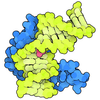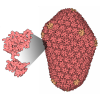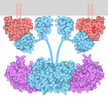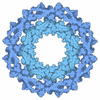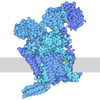+ Open data
Open data
- Basic information
Basic information
| Entry | Database: PDB / ID: 9hnw | |||||||||
|---|---|---|---|---|---|---|---|---|---|---|
| Title | USP1-UAF1 bound to Lys63-linked diubiquitin | |||||||||
 Components Components |
| |||||||||
 Keywords Keywords | HYDROLASE / USP1 / deubiquitinating enzyme / cysteine protease / complex | |||||||||
| Function / homology |  Function and homology information Function and homology informationregulation of protein monoubiquitination / positive regulation of error-prone translesion synthesis / Signaling by cytosolic PDGFRA and PDGFRB fusion proteins / monoubiquitinated protein deubiquitination / deubiquitinase activator activity / hypothalamus gonadotrophin-releasing hormone neuron development / female meiosis I / positive regulation of protein monoubiquitination / fat pad development / skeletal system morphogenesis ...regulation of protein monoubiquitination / positive regulation of error-prone translesion synthesis / Signaling by cytosolic PDGFRA and PDGFRB fusion proteins / monoubiquitinated protein deubiquitination / deubiquitinase activator activity / hypothalamus gonadotrophin-releasing hormone neuron development / female meiosis I / positive regulation of protein monoubiquitination / fat pad development / skeletal system morphogenesis / mitochondrion transport along microtubule / skin development / female gonad development / seminiferous tubule development / male meiosis I / positive regulation of intrinsic apoptotic signaling pathway by p53 class mediator / homeostasis of number of cells / protein deubiquitination / embryonic organ development / single fertilization / regulation of DNA repair / response to UV / positive regulation of double-strand break repair via homologous recombination / energy homeostasis / regulation of neuron apoptotic process / neuron projection morphogenesis / regulation of proteasomal protein catabolic process / Maturation of protein E / Maturation of protein E / ER Quality Control Compartment (ERQC) / Myoclonic epilepsy of Lafora / FLT3 signaling by CBL mutants / IRAK2 mediated activation of TAK1 complex / Prevention of phagosomal-lysosomal fusion / Alpha-protein kinase 1 signaling pathway / Glycogen synthesis / IRAK1 recruits IKK complex / IRAK1 recruits IKK complex upon TLR7/8 or 9 stimulation / Endosomal Sorting Complex Required For Transport (ESCRT) / Membrane binding and targetting of GAG proteins / Negative regulation of FLT3 / Regulation of TBK1, IKKε (IKBKE)-mediated activation of IRF3, IRF7 / PTK6 Regulates RTKs and Their Effectors AKT1 and DOK1 / Regulation of TBK1, IKKε-mediated activation of IRF3, IRF7 upon TLR3 ligation / Constitutive Signaling by NOTCH1 HD Domain Mutants / IRAK2 mediated activation of TAK1 complex upon TLR7/8 or 9 stimulation / NOTCH2 Activation and Transmission of Signal to the Nucleus / TICAM1,TRAF6-dependent induction of TAK1 complex / TICAM1-dependent activation of IRF3/IRF7 / APC/C:Cdc20 mediated degradation of Cyclin B / Downregulation of ERBB4 signaling / Regulation of FZD by ubiquitination / APC-Cdc20 mediated degradation of Nek2A / p75NTR recruits signalling complexes / InlA-mediated entry of Listeria monocytogenes into host cells / TRAF6 mediated IRF7 activation in TLR7/8 or 9 signaling / TRAF6-mediated induction of TAK1 complex within TLR4 complex / Regulation of pyruvate metabolism / NF-kB is activated and signals survival / Regulation of innate immune responses to cytosolic DNA / Pexophagy / Downregulation of ERBB2:ERBB3 signaling / NRIF signals cell death from the nucleus / VLDLR internalisation and degradation / Regulation of PTEN localization / Activated NOTCH1 Transmits Signal to the Nucleus / Regulation of BACH1 activity / Synthesis of active ubiquitin: roles of E1 and E2 enzymes / MAP3K8 (TPL2)-dependent MAPK1/3 activation / Translesion synthesis by REV1 / TICAM1, RIP1-mediated IKK complex recruitment / Translesion synthesis by POLK / InlB-mediated entry of Listeria monocytogenes into host cell / Activation of IRF3, IRF7 mediated by TBK1, IKKε (IKBKE) / JNK (c-Jun kinases) phosphorylation and activation mediated by activated human TAK1 / Downregulation of TGF-beta receptor signaling / ubiquitin binding / Josephin domain DUBs / positive regulation of protein ubiquitination / Translesion synthesis by POLI / Gap-filling DNA repair synthesis and ligation in GG-NER / IKK complex recruitment mediated by RIP1 / Regulation of activated PAK-2p34 by proteasome mediated degradation / positive regulation of epithelial cell proliferation / PINK1-PRKN Mediated Mitophagy / TGF-beta receptor signaling in EMT (epithelial to mesenchymal transition) / TNFR1-induced NF-kappa-B signaling pathway / skeletal system development / regulation of mitochondrial membrane potential / Autodegradation of Cdh1 by Cdh1:APC/C / TCF dependent signaling in response to WNT / APC/C:Cdc20 mediated degradation of Securin / Regulation of NF-kappa B signaling / N-glycan trimming in the ER and Calnexin/Calreticulin cycle / Asymmetric localization of PCP proteins / activated TAK1 mediates p38 MAPK activation / Ubiquitin-dependent degradation of Cyclin D / positive regulation of receptor signaling pathway via JAK-STAT / SCF-beta-TrCP mediated degradation of Emi1 / NIK-->noncanonical NF-kB signaling Similarity search - Function | |||||||||
| Biological species |  Homo sapiens (human) Homo sapiens (human) | |||||||||
| Method | ELECTRON MICROSCOPY / single particle reconstruction / cryo EM / Resolution: 3.04 Å | |||||||||
 Authors Authors | Keijzer, N. / Sakoltchik, J. / Sixma, T.K. | |||||||||
| Funding support |  Netherlands, 2items Netherlands, 2items
| |||||||||
 Citation Citation |  Journal: Nat Commun / Year: 2025 Journal: Nat Commun / Year: 2025Title: USP1/UAF1 targets polyubiquitinated PCNA with an exo-cleavage mechanism that can temporarily enrich for monoubiquitinated PCNA. Authors: Niels Keijzer / Jan Sakoltchik / Kaustav Majumder / Nina van Lil / Farid El Oualid / Alexander Fish / Titia K Sixma /  Abstract: DNA damage tolerance (DDT) is an important pathway that allows cells to bypass DNA lesions during replication. DDT is orchestrated by ubiquitination of PCNA, where monoubiquitinated PCNA (PCNA-Ub) ...DNA damage tolerance (DDT) is an important pathway that allows cells to bypass DNA lesions during replication. DDT is orchestrated by ubiquitination of PCNA, where monoubiquitinated PCNA (PCNA-Ub) initiates recruitment of TLS polymerases but also serves as a substrate for further ubiquitination, forming K63-polyubiquitinated PCNA that leads to HR-mediated bypass mechanisms. Recent work on USP1/UAF1 inhibition revealed that formation of K48-linked chains also occurs on PCNA, resulting in its proteasomal degradation. USP1/UAF1 is established as deubiquitinating enzyme (DUB) for PCNA-Ub, but little is known about removal of ubiquitin chains on PCNA. Here we show that USP1/UAF1 cleaves both K48 and K63-linked ubiquitin chains on PCNA efficiently, using an exo-cleavage mechanism. Kinetic analysis reveals that USP1/UAF1 prefers cleaving the ubiquitin-ubiquitin bond over cleavage of the ubiquitin-PCNA bond and therefore treats poly- and monoubiquitinated PCNA as different substrates. A cryo-EM structure of USP1/UAF1 with a K63-diubiquitin and structure-based mutagenesis suggests that this mechanistic preference is maintained in evolution. This unusual mechanism can cause temporal enrichment of monoubiquitinated PCNA during polyubiquitination. It will be interesting to see how this affects DDT pathway balance. | |||||||||
| History |
|
- Structure visualization
Structure visualization
| Structure viewer | Molecule:  Molmil Molmil Jmol/JSmol Jmol/JSmol |
|---|
- Downloads & links
Downloads & links
- Download
Download
| PDBx/mmCIF format |  9hnw.cif.gz 9hnw.cif.gz | 231.8 KB | Display |  PDBx/mmCIF format PDBx/mmCIF format |
|---|---|---|---|---|
| PDB format |  pdb9hnw.ent.gz pdb9hnw.ent.gz | 175.5 KB | Display |  PDB format PDB format |
| PDBx/mmJSON format |  9hnw.json.gz 9hnw.json.gz | Tree view |  PDBx/mmJSON format PDBx/mmJSON format | |
| Others |  Other downloads Other downloads |
-Validation report
| Summary document |  9hnw_validation.pdf.gz 9hnw_validation.pdf.gz | 1.2 MB | Display |  wwPDB validaton report wwPDB validaton report |
|---|---|---|---|---|
| Full document |  9hnw_full_validation.pdf.gz 9hnw_full_validation.pdf.gz | 1.2 MB | Display | |
| Data in XML |  9hnw_validation.xml.gz 9hnw_validation.xml.gz | 49.3 KB | Display | |
| Data in CIF |  9hnw_validation.cif.gz 9hnw_validation.cif.gz | 75.2 KB | Display | |
| Arichive directory |  https://data.pdbj.org/pub/pdb/validation_reports/hn/9hnw https://data.pdbj.org/pub/pdb/validation_reports/hn/9hnw ftp://data.pdbj.org/pub/pdb/validation_reports/hn/9hnw ftp://data.pdbj.org/pub/pdb/validation_reports/hn/9hnw | HTTPS FTP |
-Related structure data
| Related structure data |  52316MC M: map data used to model this data C: citing same article ( |
|---|---|
| Similar structure data | Similarity search - Function & homology  F&H Search F&H Search |
- Links
Links
- Assembly
Assembly
| Deposited unit | 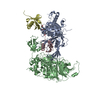
|
|---|---|
| 1 |
|
- Components
Components
| #1: Protein | Mass: 91785.992 Da / Num. of mol.: 1 / Mutation: G670A, G671A Source method: isolated from a genetically manipulated source Source: (gene. exp.)  Homo sapiens (human) / Gene: USP1 / Production host: Homo sapiens (human) / Gene: USP1 / Production host:  |
|---|---|
| #2: Protein | Mass: 80130.719 Da / Num. of mol.: 1 Source method: isolated from a genetically manipulated source Source: (gene. exp.)  Homo sapiens (human) / Gene: WDR48, KIAA1449, UAF1 / Production host: Homo sapiens (human) / Gene: WDR48, KIAA1449, UAF1 / Production host:  |
| #3: Protein | Mass: 8604.884 Da / Num. of mol.: 1 / Source method: obtained synthetically / Source: (synth.)  Homo sapiens (human) / References: UniProt: P0CG47 Homo sapiens (human) / References: UniProt: P0CG47 |
| #4: Protein | Mass: 8547.770 Da / Num. of mol.: 1 / Mutation: K63(DAB) / Source method: obtained synthetically / Source: (synth.)  Homo sapiens (human) / References: UniProt: P0CG47 Homo sapiens (human) / References: UniProt: P0CG47 |
| #5: Chemical | ChemComp-ZN / |
| Has ligand of interest | N |
| Has protein modification | Y |
-Experimental details
-Experiment
| Experiment | Method: ELECTRON MICROSCOPY |
|---|---|
| EM experiment | Aggregation state: PARTICLE / 3D reconstruction method: single particle reconstruction |
- Sample preparation
Sample preparation
| Component | Name: USP1-UAF1 bound to Lys63-linked diubiquitin / Type: COMPLEX / Entity ID: #1-#2, #4 / Source: RECOMBINANT | ||||||||||||||||||||
|---|---|---|---|---|---|---|---|---|---|---|---|---|---|---|---|---|---|---|---|---|---|
| Molecular weight | Experimental value: NO | ||||||||||||||||||||
| Source (natural) | Organism:  Homo sapiens (human) Homo sapiens (human) | ||||||||||||||||||||
| Source (recombinant) | Organism:  | ||||||||||||||||||||
| Buffer solution | pH: 7.5 | ||||||||||||||||||||
| Buffer component |
| ||||||||||||||||||||
| Specimen | Conc.: 0.75 mg/ml / Embedding applied: NO / Shadowing applied: NO / Staining applied: NO / Vitrification applied: YES | ||||||||||||||||||||
| Specimen support | Grid material: COPPER / Grid mesh size: 300 divisions/in. / Grid type: Quantifoil R1.2/1.3 | ||||||||||||||||||||
| Vitrification | Instrument: FEI VITROBOT MARK IV / Cryogen name: ETHANE / Humidity: 100 % / Chamber temperature: 277.15 K |
- Electron microscopy imaging
Electron microscopy imaging
| Experimental equipment |  Model: Titan Krios / Image courtesy: FEI Company |
|---|---|
| Microscopy | Model: TFS KRIOS Details: Collected on Krios 1 at Netherlands Center for Electron Nanoscopy (NeCEN) |
| Electron gun | Electron source:  FIELD EMISSION GUN / Accelerating voltage: 300 kV / Illumination mode: FLOOD BEAM FIELD EMISSION GUN / Accelerating voltage: 300 kV / Illumination mode: FLOOD BEAM |
| Electron lens | Mode: BRIGHT FIELD / Nominal magnification: 10500 X / Nominal defocus max: 2400 nm / Nominal defocus min: 1200 nm / Cs: 2.7 mm / C2 aperture diameter: 50 µm / Alignment procedure: COMA FREE |
| Specimen holder | Cryogen: NITROGEN / Specimen holder model: FEI TITAN KRIOS AUTOGRID HOLDER |
| Image recording | Average exposure time: 2.71 sec. / Electron dose: 50 e/Å2 / Film or detector model: GATAN K3 BIOQUANTUM (6k x 4k) / Num. of grids imaged: 1 / Num. of real images: 5833 |
- Processing
Processing
| EM software |
| ||||||
|---|---|---|---|---|---|---|---|
| CTF correction | Type: PHASE FLIPPING AND AMPLITUDE CORRECTION | ||||||
| Particle selection | Num. of particles selected: 3110350 | ||||||
| 3D reconstruction | Resolution: 3.04 Å / Resolution method: FSC 0.143 CUT-OFF / Num. of particles: 299304 / Algorithm: FOURIER SPACE / Symmetry type: POINT | ||||||
| Refinement | Highest resolution: 3.04 Å |
 Movie
Movie Controller
Controller



 PDBj
PDBj










